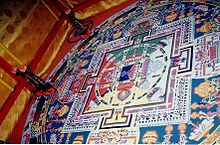- Drongtse Monastery
-
Drongtse Monastery
Sand Mandala, Drongste, 1993.Coordinates: 29°01′08″N 89°27′04″E / 29.019°N 89.451°E Monastery information Location Tsang, Tibet, China Type Tibetan Buddhist Sect Gelug Part of a series on Tibetan Buddhism
History Timeline · Related-topics Schools Nyingma · Kagyu · Sakya · Gelug · Bön · Jonang Key concepts Three marks of existence · Skandha · Cosmology · Saṃsāra · Rebirth · Bodhisattva · Dharma · Dependent origination · Karma Major figures Gautama Buddha · Padmasambhava · Je Tsongkhapa · Dalai Lama · Panchen Lama · Lama · Karmapa Lama · Rinpoche · Geshe · Terton · Tulku Buddhahood · Avalokiteśvara · Four stages of enlightenment · Tantric yoga · Paramitas · Meditation · Laity Changzhug · Drepung · Dzogchen · Ganden · Jokhang · Kumbum · Labrang · Mindroling · Namgyal · Narthang · Nechung · Pabonka · Palcho · Ralung · Ramoche · Sakya · Sanga · Sera · Shalu · Tashilhunpo · Tsurphu · Yerpa Chotrul Duchen · Dajyur · Losar · Monlam · Sho Dun Texts Kangyur · Tengyur · Tibetan canon · Mahayana sutras · Nyingma Gyubum Sand mandala · Thangka · Ashtamangala · Tree of physiology Outline · Comparative studies · Culture · List of topics · Portal
Drongtse Monastery ('Brong rtse; Pinyin: Zhongze) is a Tibetan Buddhist monastery was formerly one of the most important Gelug monasteries in Tsang, Tibet. There was also a chorten there.[1]
Drongtse Monastery, is 19 km northwest of Gyantse and 14 km north of Tsechen Monastery, on the "Southern Friendship Highway" to Shigatse,[2] and just 6 km south of the site of the early Tsi Nesar temples. It was almost totally destroyed during the Cultural Revolution, but has been partially restored since, and the Assembly Hall was rebuilt in the 1980s, though many of the main buildings remain in ruins.[3]
The original four-storied monastery was on a "rocky eminence" about 300 ft (91 m) above the village. The wall was already partly ruined when Sarat Chandra Das visited in 1881. The du-khang or congregation hall, which could seat about eighty monks, contained some very old gilt images including one of Jowo Shakyamuni said to be a copy by an Indian artist of the famous and much-revered image housed at the Jokhang in Lhasa. It also contained a picture of Lozang Gyatso, the 5th Dalai Lama (note: Das wrongly refers to him as the 1st Dalai Lama), being given political power over Tibet by the Mongol conqueror, Güshi Khan, after the king of Tsang was deposed in 1642.[4]
The monastery was, according to some, founded by Lhatsun Chenpo (Je Lha-tsun), and was the birthplace of Lobsang Palden Chophel or the Sengchen ('Lion') Lama.[5]
Other sources attribute the founding in the same year to the yogin and ascetic, Rinchen Gyatso, fulfilling a prophecy of Tsongkhapa. Later on, it was adopted as a branch monastery of Tashilhunpo. There is a small chapel behind the monastery with rock-carved images of Padmasambhava, Tara, Amitayus and other deities.[6]
Footnotes
- ^ Dowman (1988), pp. 270-271.
- ^ Tibet, p. 171. (2005) Bradley Mayhew and Michael Kohn. 6th Edition. Lonely Planet. ISBN 1-74059-523-8.
- ^ Dorje (1999), p. 261.
- ^ Das (1902), pp. 77-79.
- ^ Tibet, Past and Present: Tibetan Studies 1: PIATS 2000. Proceedings of the Ninth Seminar of the International Association for Tibetan Studies, p. 264 and note 2. Henk Blezer, A. Zadoks. Brill, Leiden 2000, ISBN 9004127755; ISBN 9789004127753.
- ^ Dorje (1999), p. 261.
References
- Das, Sarat Chandra. (1902). 'Lhasa and Central Tibet. Reprint 1988: Mehra Offset Press, Delhi, pp. 77-79.
- Dorje, Gyurme. (1999). Footprint Tibet Handbook: with Bhutan, 2nd Edition, p. 261. Footprint Travel Guides. ISBN 1900949334, ISBN 9781900949330.
- Dowman, Das (1988). The Power-places of Central Tibet: The Pilgrim's Guide. Routledge & Kegan Paul Ltd., London & New York. ISBN 0-7102-1370-0.
- Mayhew, Bradley and Kohn, Michael Tibet. (2005). 6th Edition. Lonely Planet. ISBN 1-74059-523-8.
Coordinates: 28°57′N 89°32′E / 28.95°N 89.533°E
Buddhist monasteries in Tibet Lhasa Prefecture Ani Tsankhung Nunnery · Drepung Monastery · Drigung Monastery · Ganden Monastery · Jokhang · Kundeling Monastery · Muru Nyingba Monastery · Namgyal Monastery · Nechung · Nyethang Drolma Lhakhang Temple · Ramoche Temple · Reting Monastery · Sanga Monastery · Taklung Yarthang Monastery · Tradruk Temple · Tsomon Ling · Tsurphu Monastery · Yangpachen Monastery · Yerpa · Zhuowaqudeng Monastery
Sera Monastery: · Chupzang Nunnery · Drakri Hermitage · Garu Nunnery · Jokpo Hermitage · Keutsang Hermitage · Keutsang East Hermitage · Keutsang West Hermitage · Khardo Hermitage · Negodong Nunnery · Nenang Nunnery · Pabongkha Hermitage · Panglung Hermitage · Purbuchok Hermitage · Rakhadrak Hermitage · Sera Chöding Hermitage · Sera Gönpasar Hermitage · Sera Utsé Hermitage · Takten Hermitage · Trashi Chöling HermitageShannan Prefecture Shigatse Prefecture Changmoche Monastery · Lhatse · Chokorgyel Monastery · Daklha Gampo · Dorje Pakmo · Drongtse Monastery · Donggar Monastery · Garju Monastery · Manmogang Monastery · Menri Monastery · Milarepa's Cave · Narthang Monastery · Ngor · Palcho Monastery · Ralung Monastery · Samding Monastery · Sakya Monastery · Ṣalu Monastery · Shelkar · Tashilhunpo · Tsi Nesar · Tsechen Monastery and DzongNgari Prefecture Chamdo Prefecture
and former KhamGalden Jampaling Monastery · Karma Gon Monastery · Benchen Monastery · Dorje Drak · Dzogchen Monastery · Dzongshar Monastery · Kandze Monastery · Katok Monastery · Nanwu Si Monastery · Palyul · Riwoche Monastery · Shechen Monastery · Surmang · Tongkor ·Nyingchi Prefecture Categories:- Buddhist monasteries in Tibet
- Buddhist temples in Tibet
- 1442 establishments
- Xigazê Prefecture
- Gelug monasteries
Wikimedia Foundation. 2010.



